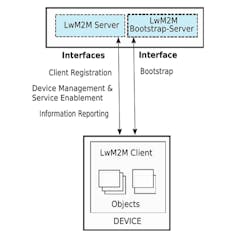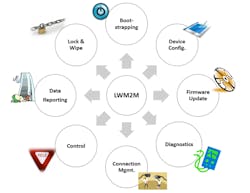This article appeared in Electronic Design and has been published here with permission.
All industry analysts seem to agree on one thing: The IoT market will grow at one of fastest rates of any modern technology over the coming years. For example, according to the analysts at specialist industry firm IHS Markit, more than 62 billion devices1 will be connected by the year 2023, essentially doubling the size of the market from its 2019 benchmark.
But it’s not just the rate of growth that could cause headaches for those trying to support this explosion of opportunity. Alongside the ramp up, the scope and complexity of the solutions will also expand as system integrators and service providers seek to bring together a cosmopolitan mix of components, products, and software from different direct and third-party vendors up and down the entire value chain.
The New Device Breed
Two developments will have fundamental roles to play in fueling the growth and the complexity of IoT solutions: A developing breed of low-cost, low-power devices; and the advent of 5G and other supporting networks able to support the connectivity demands.
This new breed of devices will likely have limitations in terms of computing power, memory, and wireless bandwidth, frequently operating on battery power alone. Yet despite their limitations—in fact, because of those limitations—these edge devices that will be fundamental to the market growth also need to provide the highest standards of network security in concert with low-touch, low-cost, device management.
At the same time, the advent of 5G networks—with their promise of revolutionary speeds, low latency, high resilience, network elasticity, guaranteed quality of service, density of deployment, energy efficiency, scalability, and other game-changing aspects—will create unprecedented opportunities for business innovation.
The IoT will be a major focus of that innovation and be at the core of digital transformation projects across all industries and verticals. But the IoT industry is also highly fragmented. What’s more, as that fragmentation is likely to remain in place for many years, a unified approach to device management across all application areas is critical for solution providers.
Unified configurable management software shortens development lifecycles and the repurposing of software and hardware solutions across a variety of use cases. It also enables solutions to be scaled both horizontally across application areas and vertically in deployment size.
OMA LwM2M
To that end, the industry, through the Open Mobile Alliance (OMA), has come together to create a standard to address the need to remotely manage IoT devices in magnitudes that go from a few devices to many millions. The standard, aligned to current practices and principles in architecture and wireless readiness, gives system integrators and solution providers a base on which to build their network configurations and management tools. That standard is the OMA Lightweight Machine to Machine communications protocol—LwM2M—and a white paper2 was published by the OMA earlier this year to highlight the work and outline some use cases. The public document can be accessed here.
One of the most important things about the LwM2M standard is that it’s available today and is 5G-ready for future networks. LwM2M aims to harmonize the IoT ecosystem and provide a comprehensive and flexible long-term solution, particularly for device management and service enablement purposes (Fig. 1).
Its key benefits are:
- Efficient protocol design, to address a vast range of devices including resource-constrained ones (Fig. 2).
- Standards-centric and leveraging IETF core RFCs.
- Extensible Object Data Model that enables new high-value functions. New Objects are being added on a regular basis by OMA/IPSO, third-party industry associations, and vendor ecosystems (Fig. 3).
- Secure and robust, with transport and application-layer security
These benefits make LwM2M perfect for today’s deployments, but they also pave the way to harmonize with full 5G networks.
Most current 5G deployments are non-standalone networks delivering primarily fixed wireless services using existing 4G infrastructure to support a 5G radio path. The next wave of standalone 5G will incorporate a completely new core network as well as a 5G radio access network; these developments will see an exponential rise in service innovation (Fig. 4).
The advent of the core 5G infrastructure will unleash the capability of a 5G network to be “sliced” with each part of the network able to operate at different parameters of speed, latency, and device density. All of them will be aligned with the specific application type, from simple enhanced mobile broadband to ultra-reliable low-latency communications for automotive applications, and to the massive IoT deployments predicted by the analysts.
The extreme configurability of these standalone 5G networks will require that standards for device management mature in harmony with these advances both in pace and dimension. The LwM2M standard will make a major contribution to this requirement as it was conceived from the outset to support massive deployments.
Dealing with Device Management
In contrast, this exponential increase in the density and number of device endpoints will stress and crack legacy approaches to device management. In fact, some of the first adopters are already reporting issues with the current state of device management. A recent survey by research firm IDC3 found “security and cost continue to be the top inhibitors to IoT projects” and that “organizations continue to struggle with skills gaps and infrastructure readiness.”
This balance between the complexity and capability of new networks, and the power and processing limits of the simple mass IoT devices deployed, is a key challenge addressed by the LwM2M standard.
To work effectively, these devices must be abundantly configurable and over-the-air upgradable in order to be able to recover from issues, stay compliant, and support new capabilities as networks evolve. In the massive IoT scenario, having to physically touch even a small fraction of a large deployment for upgrades and software issue resolution could break the business case.
When LTE-M and NB-IoT entered the IoT stage, LwM2M became the natural path for the industry looking for a device-management solution because it was specifically designed to address this requirement of low-powered, low-data, resource-constrained devices and could easily incorporate cellular IoT network technologies.
During its development, LwM2M was extended to support new requirements and features for the emerging cellular IoT network technologies.
Adoption of LwM2M across verticals and use cases is growing in areas such as automotive, agriculture, smart city, smart metering, and asset tracking. Major mobile network operators globally have already deployed LwM2M servers in full production environments, many of them requiring LwM2M support for network device approvals.
Interest in the LwM2M standard and approach is now well-rooted across the industry, with leading hardware and chipset makers embracing it. This will result in the number of LwM2M-compliant devices rising at faster pace throughout 2020 and beyond.
LwM2M is an ideal device-management solution for massive IoT—many success stories can be found within existing LTE-M and NB-IoT deployments. Because the technology-independent aspects of device management are already addressed in LwM2M, it will remain the standard of choice as it grows to cover a broader scope of use cases and device types in 5G. And it will be supported by the the OMA’s cross-industry device-management and service-enablement working group.
Martino Turcato is Product Manager, IoT Software and Services, at Telit.
References




